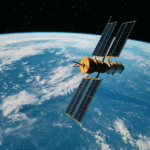Interplanetary exploration stands at the frontier of human endeavor, pushing the boundaries of what we understand about the universe. At the heart of this grand pursuit lies the necessity for effective communication between Earth and space probes scattered across the cosmos. Interplanetary wireless communication emerges as the lifeline enabling this dialogue, facilitating the transmission of vital data, commands, and discoveries over vast distances. This introduction sets the stage for exploring the pivotal role of wireless networks in the ongoing saga of space exploration.
Evolution of Interplanetary Communication
Interplanetary communication has undergone a remarkable evolution since the inception of space exploration. Initially, communication between Earth and spacecraft relied on basic radio transmissions, limited in range and data capacity. The early days of interplanetary exploration saw significant challenges, including long communication delays due to vast distances and signal degradation caused by cosmic interference.
However, advancements in technology and engineering have propelled interplanetary communication into new frontiers. The establishment of the Deep Space Network (DSN) by NASA in the 1960s marked a pivotal moment, providing a global network of antennas capable of communicating with spacecraft throughout the solar system. This network facilitated the exchange of data, commands, and telemetry, enabling unprecedented exploration of distant worlds.
As space missions became more ambitious, with probes sent to explore planets, moons, and asteroids, the need for reliable and robust communication systems became increasingly apparent. Engineers developed innovative solutions to overcome the challenges posed by interplanetary distances, such as error-correcting codes to ensure data integrity and adaptive communication protocols to adjust to changing conditions in space.
The evolution of interplanetary communication has also been driven by advances in computing and signal processing. The development of sophisticated onboard computers allowed spacecraft to process and compress data before transmission, maximizing the efficiency of communication links. Meanwhile, improvements in signal modulation and coding techniques enhanced the reliability and speed of data transmission over long distances.
Technologies Driving Interplanetary Wireless Networks
Interplanetary wireless networks rely on a combination of cutting-edge technologies to facilitate communication across vast distances in space. These technologies are essential for enabling data transmission between spacecraft, orbiters, rovers, and Earth-based stations. Here are some key technologies driving interplanetary wireless networks:
Deep Space Network (DSN):
- The Deep Space Network, operated by NASA, is a vital component of interplanetary communication.
- It consists of a network of ground-based antennas strategically positioned around the globe.
- These antennas communicate with spacecraft across the solar system, providing continuous coverage for missions exploring distant planets, moons, and beyond.
Interplanetary Internet Protocols:
- Traditional internet protocols are not suitable for interplanetary communication due to the vast distances and signal delays involved.
- To address this challenge, researchers have developed specialized protocols, such as the Delay-Tolerant Networking (DTN) protocol suite.
- DTN enables reliable communication in environments where traditional networks would fail, allowing spacecraft to store and forward data packets until they reach their destination.
Laser Communication:
- Laser communication, also known as optical communication, offers higher data transfer rates and lower signal degradation compared to traditional radio frequency (RF) communication.
- This technology utilizes lasers to transmit data between spacecraft and ground stations, enabling faster and more efficient communication over long distances.
- NASA’s Lunar Laser Communication Demonstration (LLCD) and Laser Communications Relay Demonstration (LCRD) are examples of missions testing the feasibility of laser communication in space.
Software-Defined Radios (SDRs):
- Software-defined radios provide flexibility and adaptability in interplanetary communication systems.
- Unlike traditional radios, which are hardware-based and have limited functionality, SDRs use software to configure and modify communication parameters, allowing for easier upgrades and customization.
- SDRs play a crucial role in optimizing communication performance and adapting to changing mission requirements.
Artificial Intelligence (AI) and Autonomy:
- AI-powered communication systems enable spacecraft to autonomously manage communication tasks, such as scheduling transmissions, optimizing data routing, and adapting to changing network conditions.
- Machine learning algorithms can analyze data patterns and predict future communication needs, improving overall efficiency and reliability in interplanetary networks.
Applications and Benefits
The applications and benefits of interplanetary wireless networks are vast and far-reaching, revolutionizing the way we explore space and gather information about distant celestial bodies. Here are some key applications and benefits:
Real-time Data Transmission:
- Interplanetary wireless networks enable real-time transmission of data from spacecraft, rovers, and orbiters to Earth-based stations.
- This capability allows scientists and engineers to receive up-to-date information about planetary conditions, geological features, and atmospheric phenomena, facilitating ongoing research and exploration.
Remote Operation and Control:
- Wireless communication networks allow for remote operation and control of robotic missions on distant planets and moons.
- Through these networks, scientists can send commands to spacecraft and rovers, maneuvering them to specific locations, conducting experiments, and collecting samples without the need for direct human intervention.
Enhanced Scientific Discoveries:
- By enabling seamless communication between Earth and space, interplanetary wireless networks support scientific discoveries and breakthroughs in fields such as astronomy, planetary science, and astrobiology.
- Access to real-time data and imagery from remote locations helps researchers analyze planetary environments, study celestial phenomena, and search for signs of extraterrestrial life.
Spacecraft Autonomy:
- Wireless networks empower spacecraft with greater autonomy and decision-making capabilities.
- Advanced communication systems equipped with artificial intelligence algorithms enable spacecraft to adapt to changing conditions, prioritize data transmission, and make autonomous navigation decisions, enhancing overall mission efficiency and success.
Collaborative Exploration:
- Interplanetary wireless networks foster collaboration and cooperation among space agencies, research institutions, and international partners.
- Shared access to communication infrastructure allows for joint missions, data sharing, and collaborative research initiatives, maximizing resources and expertise to achieve common exploration goals.
Public Engagement and Education:
- Accessible communication channels provided by interplanetary wireless networks enable public engagement and education initiatives, allowing people around the world to participate in space exploration activities.
- Live broadcasts, educational outreach programs, and interactive platforms foster interest in science, technology, engineering, and mathematics (STEM) fields and inspire the next generation of space explorers.
Conclusion
In conclusion, interplanetary wireless networks revolutionize space exploration by facilitating real-time data transmission, remote operation of missions, and collaborative research. These networks, powered by advanced technologies, enable humanity to push the boundaries of knowledge and inspire public engagement in space exploration. As we continue to advance these networks, we open doors to endless possibilities and expand our understanding of the cosmos, propelling us toward new frontiers of exploration and discovery.












